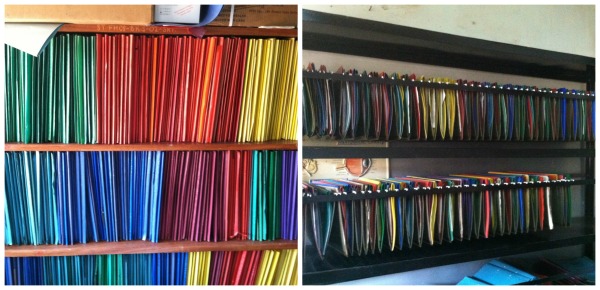Editors’ Note: This summer, four medical students and two research trainees from Albert Einstein College of Medicine traveled to Soroti, Uganda, to treat diabetes as part of Einstein’s Global Diabetes Institute. We are featuring a series of posts detailing their challenges and progress. In this post, second-year M.D. student Madelyn Klugman shares her experiences. The students’ trip was funded by Einstein’s Global Health Fellowship Program.

Before and After: Files at the Soroti, Uganda medical clinic became easier to use with less potential for lost information. Photo by Anneka Wickramanayake
“What color is your folder?”
“Blue,” the patient replied.
I went into another room to hunt through the pile of blue folders, looking for that patient’s name. I sighed. “I don’t see it.”
The patient was brought in. “Are you sure that your folder is blue? Could it be a different color?”
This was translated to the patient in Ateso, the local language. She then pointed to a stack of folders—green, not blue. An easy mistake. But a mistake that wastes precious time in the busy clinic, in which one nurse and a few doctors see a hundred patients a day and are responsible for all the record-keeping.
When I learned I was headed to Soroti, Uganda, to work in one of that country’s medical clinics, our long-term goal was ambitious: create an electronic medical record (EMR) system for its diabetes patients. An electronic system would enable doctors to monitor their patients more efficiently and conduct research to see if future interventions (such as patient education) would improve patient outcomes. This would be particularly helpful in Uganda, where diabetes affects at least 750,000 people and is on the rise. (Note: this disease is underreported due to a lack of screening and adequate healthcare in many parts of Uganda.) While EMRs are widely used in the United States, the cost, time and expertise needed to implement and maintain them has slowed their use in many countries, and we were excited to help.
While we knew that we would not be able to implement an EMR system fully by the end of the summer, the early steps in the process took longer than any of us expected.
The first challenge was that the clinic’s existing system was entirely paper-based. Whatever electronic system we devised would have to be built from the ground up.
Another major challenge was the sheer number of diabetes patients who are seen in a single day. They all need to have their blood drawn (which can take a long time if a patient is dehydrated, which is fairly common), have finger-prick tests and have their blood pressure, height and weight recorded. Generally, there is one nurse to take these measurements. (She’s a superhero, but she does have only two hands.) As the example of the colored folders suggests, patients’ data were recorded in their permanent files, which were all paper records, and in the patients’ personal records, which are little exercise booklets that they take with them to and from the clinic. By implementing the electronic system, we would be adding another step, so it had to be quick and simple—and ultimately save staff time.
Another hurdle the clinic struggled with arose because of the lack of literacy. The language is more commonly spoken than written, and it can be confusing to try to determine if two patients with similar-sounding names are in fact the same. Often, the same village name is spelled many different ways. This can make it difficult and time-consuming to distinguish patient records.
Once we better understood these realities, we worked with the clinic staff to arrive at a practical system that would ease their daily work: assigning a diabetes reference number to each patient and creating an Excel spreadsheet to input baseline data. We worked with the staff to implement this system, which is based on the model the hospital currently uses in its HIV/AIDS clinic. We created a handwritten registry to match our electronic database, assigned every patient a number, organized the permanent paper files numerically and installed a filing cabinet. This system will make it much easier for the staff to find a file and look up information for a specific patient, saving valuable time. Ideally, this system can also be used to track individual patients and the clinic’s patient population over time and will smooth the transition to full electronic medical records.
During our last week in Soroti, we met with the permanent staff to discuss how the project will continue in our absence. It was exciting to hear about the full database system that the clinic plans to implement. Furthermore, now that baseline data have been recorded, evaluation of diabetes patient education will commence.
The staff appreciated our efforts, and I felt a real sense of partnership. Even though data collection and entry may not be the most glamorous aspect of global health, the staffers expressed satisfaction that their number-one priority was addressed this summer.
I came to learn the importance of listening to the priorities of the local staff, rather than our own. It might mean completing a seemingly simple task such as moving all of the furniture. But that act allowed us to bring in a new file cabinet and take care of files that seriously needed sorting. The impact of our actions improved the clinic’s ability to monitor patients, evaluate their overall health and implement further interventions. In the long run, this can be life-saving.
This project reminded us that if we address only our own priorities, the changes we make may not address the biggest problems faced by the staff.

